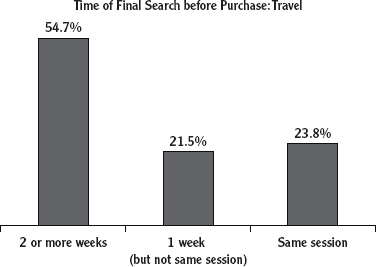ATTRIBUTION
Attribution issues make metrics even more complicated. As we’ve seen, searchers don’t always follow a straight path from search to purchase. They not only may search for several different things (with subsequent queries triggered in part by results they saw in earlier queries) but may also search over more than one session. One study found that 56 percent of purchases occur in a search session later than the first one.6 Another found that only 43 percent of purchasers make that purchase within an hour of the site visit.7 For some categories, the lag times can be substantial, such as shown in Figure 8.2.
eBay, which we’ll learn more about shortly, handles the attribution issue in its metrics by using cookie data to store visitor information and attributing a conversion to search if it happens within 24 hours. The numbers tell us that this method isn’t perfect, but it’s better than attributing conversions only at the point of searching.
In addition to the time lag element of attribution, there’s the triggering element. We can see this in a hypothetical example for Volvo. In this example, we’ll consider entering a zip code to find the nearest dealer a conversion (Figure 8.3).
Figure 8.3 Conversion Metrics from Multiple Channels
Looking at these hypothetical numbers separately, branded search converts significantly ...
Get Marketing in the Age of Google: Your Online Strategy IS Your Business Strategy, Revised and Updated now with the O’Reilly learning platform.
O’Reilly members experience books, live events, courses curated by job role, and more from O’Reilly and nearly 200 top publishers.


